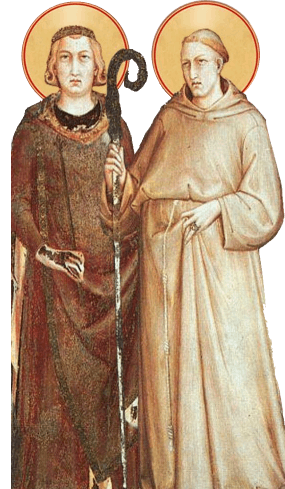
13 August
Optional Memorial
St Pontian, Pope & St Hippolytus, Priest
Martyrs
POPE ST PONTIAN
18th Pope of the Catholic Church
Papacy began 21 July 230 Papacy ended 28 September 235
Predecessor Urban I Successor Anterus
Died October 235 Sardinia, Roman Empire
ST HIPPOLYTUS
Born vs. 170 AD Rome
Died c. 235 AD (aged 64-65) Sardinia
St. Pontian (Pontianus) was a victim of the persecution of Alexander Severus, who directed his attention particularly against the leaders of the Church. St. Pontian governed the Church from 230 to 235. He was exiled to the mines of Sardinia and died in exile. St. Hippoytus, a priest and a person of some importance in the Church in Rome at the beginning of the third century, provoked a schism which lasted for some years. He was exiled to Sardinia with St. Pontian, where he was reconciled with the Church and died for the faith in 235.
COLLECT PRAYER
May the precious long-suffering of the just, O Lord, we pray, bring us a great increase of love for you and always prompt in our hearts constancy in the holy faith. Through our Lord Jesus Christ, your Son, who lives and reigns with you in the unity of the Holy Spirit, God, for ever and ever.
Sts. Pontian and Hippolytus
As kind as Severus might have been to the Christians, his successor Maximus Thrax persecuted them. Although Maximus was not a religious man himself, he despised Severus and intended to reverse any attitude to which Severus might have been disposed. He therefore decreed that leaders of the Church be singled out and banished to the labor mines of Sardinia, the famous “Island of Death.”
Pontian, a Roman and son of Calpurnius, had enjoyed a peaceful reign over the Roman Church during Severus’ time, but soon found himself among the first victims of this new emperor. Rounded up with the antipope Hippolytus, Pontian was deported to the labor mines. Since deportation was a life sentence which few survived, Pontian felt obligated to abdicate so that a successor might quickly preside over the Holy See. He is the first pope known to have abdicated.
While imprisoned, Hippolytus reconciled his differences with Pontian and even ordered his followers to bring themselves back to the Church. Before he succumbed to the harsh treatment of the mines, Hippolytus became a true confessor of Christ.
Pontian, in the mines only two months, was brutally beaten to death by his jailers. His body, with that of Hippolytus, was returned to Rome approximately a year later, during the pontificate of Fabian. He was buried in the cemetery of Calixtus and was rightfully honored by the Church as a martyr.
Excerpted from The Popes: A Papal History, J.V. Bartlett
Source: CATHOLIC CULTURE
St. Pontian
(Taken from Catholic Encyclopedia)
The “Liber Pontificalis” (ed. Duchesne, I, 145) gives Rome as his native city and calls his father Calpurnius. With him begins the brief chronicle of the Roman bishops of the third century, of which the author of the Liberian Catalogue of the popes made use in the fourth century and which gives more exact data for the lives of the popes. According to this account Pontian was made pope 21 July, 230, and reigned until 235. The schism of Hippolytus continued during his episcopate; towards the end of his pontificate there was a reconciliation between the schismatic party and its leader with the Roman bishop. After the condemnation of Origen at Alexandria (231-2), a synod was held at Rome, according to Jerome (Epist. XXXII, iv) and Rufinus (Apol. contra Hieron., II, xx), which concurred in the decisions of the Alexandrian synod against Origen; without doubt this synod was held by Pontian (Hefele, Konziliengeschichte, 2nd ed., I, 106 sq.). In 235 in the reign of Maximinus the Thracian began a persecution directed chiefly against the heads of the Church. One of its first victims was Pontian, who with Hippolytus was banished to the unhealthy island of Sardinia. To make the election of a new pope possible, Pontian resigned 28 Sept., 235, the Liberian Catalogue says “discinctus est”. Consequently Anteros was elected in his stead. Shortly before this or soon afterwards Hippolytus, who had been banished with Pontian, became reconciled to the Roman Church, and with this the schism he had caused came to an end. How much longer Pontian endured the sufferings of exile and harsh treatment in the Sardinian mines is unknown. According to old and no longer existing Acts of martyrs, used by the author of the “Liber Pontificalis”, he died in consequence of the privations and inhuman treatment he had to bear. Pope Fabian (236-50) had the remains of Pontian and Hippolytus brought to Rome at a later date and Pontian was buried on 13 August in the papal crypt of the Catacomb of Callistus. In 1909 the original epitaph was found in the crypt of St. Cecilia, near the papal crypt. The epitaph, agreeing with the other known epitaphs of the papal crypt, reads: PONTIANOS, EPISK. MARTUR (Pontianus, Bishop, Martyr). The word mártur was added later and is written in ligature [cf. Wilpert, “Die Papstgräber und die Cäciliengruft in der Katakombe des hl. Kalixtus” (Freiburg, 1909), 1 sq., 17 sq., Plate III]. He is placed under 13 Aug. in the list of the “Depositiones martyrum” in the chronographia of 354. The Roman Martyrology gives his feast on 19 Nov.